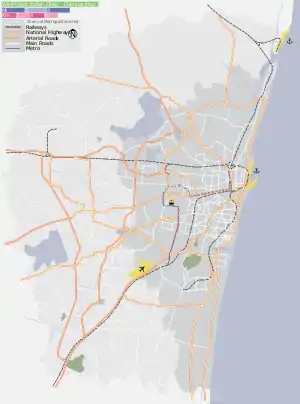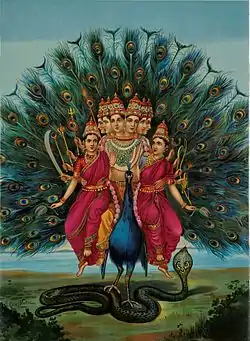Kandaswami Temple, Georgetown
Kandaswami Temple (Tamil: கந்த சுவாமி கோவில்) is a Hindu temple dedicated to Lord Murugan, located in the Parry's corner (Old: George Town)[1] neighbourhood of Chennai city, in Tamil Nadu, India. It is also called 'Mutthu Kumāra Swāmi deva sthānam' (Tamil: முத்து குமார சுவாமி ஸ்தானம்) and popularly known as Kandha kottam (Tamil: கந்த கோட்டம்).[2] It is managed by the Tamil Nadu Hindu religious and charitable endowments department[3] of the government of Tamil Nadu. The Kandha kottam temple has associated educational institutions for music and dance classes; primary and high schools; and a college,[4] in various locations. The Kandha kottam temple also performs social welfare initiatives like free medical clinics[4] and free pharmacies.[4]
| Kandha Kottam Temple Tamil: கந்த கோட்டம் திருக்கோவில் | |
|---|---|
Kandha Swāmi Temple (கந்த ஸ்வாமி திருக்கோவில்)
Mutthu Kumāra Swāmi deva sthānam (முத்து குமார ஸ்வாமி தேவ ஸ்தானம்) | |
| Religion | |
| Affiliation | Hinduism |
| District | Chennai district |
| Deity | Thiru Kandha Swāmi (Murugan)
Shri Deivānai, Shri Valli |
| Festivals | ādi Kirutthigai, Panguni Utthiram. |
| Location | |
| Location | Parry's corner (Old: George town), Chennai city |
| State | Tamil Nadu |
| Country | India |
 Location in Chennai city | |
| Geographic coordinates | 13.0939°N 80.2839°E |
| Architecture | |
| Type | Dravidian architecture |
| Completed | 1670s CE, early 1800s CE |
| Website | |
| kandhakottam | |
History
The original temple was constructed by the Maari Chettiar in the 1670s.[5] The existing[6] temple was built with stone in the very early 1800s.[5] It has seen many renovations, and is considered to be one of the finest in the neighbourhood. The area covered by the temple is about eight acres.[5] The temple tank is 'Saravana Poigai' and the Sthala Viruksham (tree) is Magizham tree.
According to the stone inscriptions[5] in the temple, the moolavar vigraham (main idol) of Murugan in this temple was discovered[7] and brought from a tank bund near Thiru porur Shri Kandha Swāmi Temple. It is a famous Murugan temple situated on the Chennai to Mahabalipuram route and that vigraham was installed in this temple during the 1670s.[5]
Deities

The moolavar vigraham 'Shri Kandha swāmi',[6] (ஸ்ரீ கந்த ஸ்வாமி) which was brought from 'Thiru porur', is about two feet in height. Shri Deivānai (ஸ்ரீ தெய்வானை) and Shri Valli (ஸ்ரீ வள்ளி) are on either side of this presiding deity. The uthsava moorthi is known as 'Shri Mutthu kumāra swāmi'[6] (ஸ்ரீ முத்து குமார ஸ்வாமி), has consorts Deivānai and Valli. They are in a separate shrine in a big uthsava mandapam. Next to the temple tank[7] Saravana poigai, there is a shrine for Shri Kulakkarai Vināyagar with Siddhi and Buddhi as his consorts. There is a shrine nearby for Shri Kāshi Vishwanādhar and Shri Kāshi Vishālākshi.
At the entrance of this temple, there is a hall called 'Parivedan mandapam'. Sculptured images of Vezha mugatthu Vināyagar in sitting and standing positions are kept on either side of the mandapam. To the front of the Artha mandapam, there is a 'dwaja sthambam' (Flag Staff). The Mukha mandapam is where the idols of Sarva Siddhi Vināyagar, Meenākshi Sundareswarar, Idumban, Rāmalinga Swāmigal (Vallalār),[7] and Pāmban Swāmigal[7] are found.
Rāmalinga Vallalār and Kandha kottam
The Kandha kottam temple[8] is associated with the life of the saint Rāmalinga Swāmigal (Vallalār, வள்ளலார்), who composed 'Deiva mani malai' here.
Saint Rāmalingam (1823 – 1874) was a small child when he relocated with his mother to Chennai in 1826; after the death of his father in 1824. He and his mother lived with his eldest brother Sabhapati and his wife Pāppāthi at 31/14 Veerasamy Pillai Street, Sevenwells, Chennai-600001, which is in the area near Kandha kottam temple. During visits to the temple, when the priest offered the Deepa aradhana (adoration by lighted lamp being brought close to the vigrahams), this was perceived by Rāmalingam as a deep spiritual experience. In later years he said of the experience:
- "No sooner the Light was perceived, happiness prevailed on me", and
- "The sweet nectar was tasted by me as soon as the Arut perun jothi (Supreme Grace Of Light) became visible".[9]
After Rāmalingam reached five years of age, Sabhapati initiated his formal education. But the young child was not interested in that, instead he preferred trips to the nearby Kandha swāmi temple. Sabhapati thought that the child needed punishment as a form of discipline, and he told his wife not to give Rāmalingam his daily meal. His kind sister-in-law, however, secretly gave him food and persuaded him to study seriously at home. In return, Rāmalingam asked for his own room, lighted lamp and mirror. He placed the light in front of the mirror. He started meditation by concentrating on the light and thus began the young boy's spiritual life. He miraculously saw a vision of the Lord Muruga. Rāmalingam said:
- "The beauty endowed divine faces six, the illustrious shoulders twelve."[10]
At one time, Rāmalingam had to replace his elder brother Sabhapati at an upanyāsam (religious stories) session. His great discourse on verses from the `Periya purānam', an epic poem by Sekkizhar about the saintly '63 Nāyanārs', was appreciated by the devotees as being given by a very learned scholar. Rāmalingam's mental and spiritual growth progressed rapidly. Rāmalingam says thanks to the Divine by:
- "Effulgent flame of grace, that lit in me intelligence, to know untaught."[11]
Saint Rāmalingam evolved in his spiritual journey from being a devout devotee of Lord Siva to worshipping the formless.
Festivals
| Part of the series on |
| Kaumaram |
|---|
 |
|
The Kandha kottam temple has its famous yearly[12] festivals of ādi's Kirutthigai with silver car, Aippasi's Kandha Shashti & Deivānai Thiru kalyānam, Karthigai's Deepam, Thai's Brahmotsavam, Thai Poosam, Panguni's Utthiram and the monthly[13] festivals of Kirutthigai and Kandha Shashti. The temple has weekly[13] 'Arut perun jothi Agaval' song on every Thursday and its daily[13] āru jāma poojai (six times a day worship).
References
- Muthiah, S. (2004). Madras Rediscovered. East West Books (Madras) Pvt Ltd. p. 329. ISBN 81-88661-24-4.
- Location, contact details from kandhakottam.tnhrce.in retrieved 2017-01-27. Address: Kandha Kottam Temple, #44, Rasappa Chetty Street, Flower Bazār, Park Town, Chennai - 600 003, TamilNadu, India.
- "Official Website of Arulmigu Kandhakottam Temple - Home". kandhakottam.tnhrce.in. Retrieved 27 January 2017.
- "Temple administration". Official temple website. Retrieved 26 January 2017.
- "Social Activities of temple". Official temple website. Retrieved 26 January 2017.
- "History of Kandha kottam temple". Kandha kottam temple official website. Retrieved 26 January 2017.
- Kandha kottam temple official website photo gallery retrieved 2017-01-27; shows photos of gopurams, vigragams and shrines.
- Kantha kottam temple photo gallery at temple.dinamalar.com, retrieved 2017-01-27; shows photos of image depicting main idol discovery in Thiruporur, temple tank, idols of Vallalār, Pāmban swāmi.
- "Chennai Kandha kottam at Kaumaram.com".
- Arutperunjothi Archived 2008-09-16 at the Wayback Machine, Tamil Nadu Text books online
- Lakshmi Devnath, "Compassion is the essence of his philosophy" Archived 2011-01-07 at the Wayback Machine, The Hindu, 2 February 2001
- Early ages of Vallalar
- "Yearly festivals calendar". Official temple website. Retrieved 26 January 2017.
- "Poojai calendar- Monthly, weekly, daily".